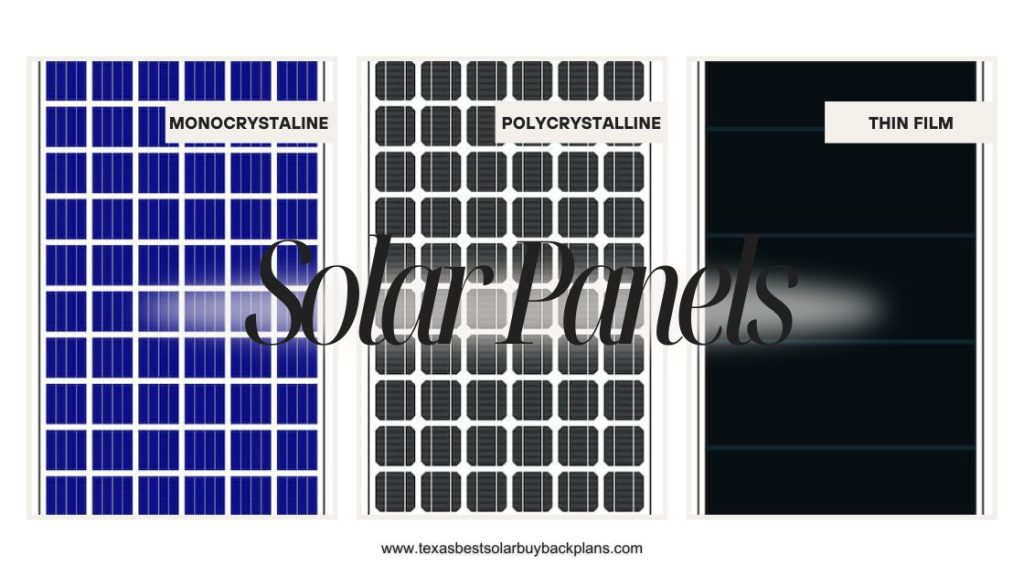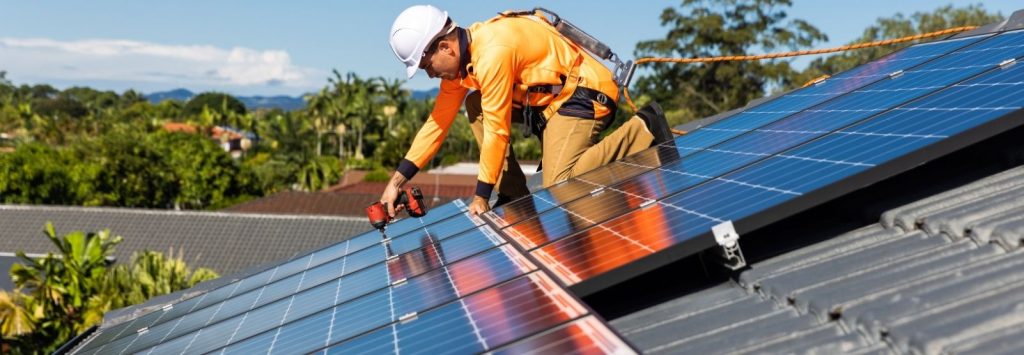The Cost of Solar Panels in Texas: How Much Does It Really Take to Go Solar?
Investing in solar panels for your Texas home isn’t just about upfront costs—it’s about understanding what you’re getting in return. In 2023, the average cost of a 10kW solar system ranges from $20,000 to $25,000 after the 30% federal solar tax credit is applied.
Here’s a quick breakdown:
| System Size | Average Cost |
|---|---|
| 5 kW | $15,000 |
| 6 kW | $18,500 |
| 7 kW | $20,000 |
| 8 kW | $21,500 |
| 10 kW | $22,500 |
What Affects Solar Panel Costs?
Several factors influence the overall price of your solar installation, including:
- Type of solar panels: Monocrystalline vs. Polycrystalline, or PERC panels, all vary in cost and efficiency.
- Quantity of panels: The number you need depends on your home’s energy consumption.
- Installation costs: These vary depending on your location and labor rates.
- Inverter type: Microinverters, while more expensive, can improve system efficiency over string inverters.
- Permits and utility fees: These can add up depending on your local regulations.
- State and local tax incentives: Always check for available rebates and credits.
Types of Solar Panels
When choosing solar panels, you’re mainly looking at Monocrystalline, Polycrystalline, and PERC panels. Each has its own cost and efficiency trade-offs, but Monocrystalline panels tend to be more efficient and slightly pricier, while Polycrystalline panels are more affordable but less efficient.

How Many Solar Panels Do You Need for Your Home?
Determining how many solar panels you need for your home involves understanding your energy consumption, the panel output, and considering environmental factors. Let’s break it down:
- Energy Consumption: The first step is to determine how much energy your home uses annually. This information can be found on your utility bill, usually listed in kilowatt-hours (kWh). For a more accurate estimate, look at your total usage over a year. It’s important to remember that without batteries, solar panels only produce energy when the sun is up, so your system likely won’t offset 100% of your consumption unless it's designed to overproduce during daylight hours.
- Panel Output: Each solar panel has a rated capacity in watts (W), which represents the amount of power it can generate in ideal conditions (like at noon on the equator on a sunny day). To figure out how much energy a panel can generate, multiply its wattage by the number of hours of sunlight your area receives. For example, if your panel is rated at 300W and your location receives 5 hours of direct sunlight per day, each panel will generate 1.5 kilowatt-hours (kWh) daily. Multiply that by the number of days in the year to get a rough annual production estimate.
- Consider Losses: The actual energy your panels will produce depends on several factors, including location, roof angle, and shading. Even under ideal conditions, you won’t receive the exact wattage rating from your panels every hour of the day. The further you are from the equator, the more you may need to account for losses. As a general rule of thumb, adding extra panels can help ensure you generate enough power to meet your energy needs, especially on cloudy or less sunny days.
- Net Energy Metering (NEM): If you’re connected to the grid and your utility company offers Net Energy Metering, you can produce more energy than you need during the day and send the excess to the grid, receiving credits on your utility bill. This allows you to balance your energy costs, even if your solar system doesn’t produce energy at night. Overproducing during sunny hours could result in big savings if NEM credits are available, but it’s essential to know your utility's policies.
- Rule of Thumb: On average, a typical home requires between 20 to 30 solar panels to meet its energy needs, depending on the home’s energy consumption, the wattage of the panels, and the amount of sunlight received. With proper installation and alignment, you can maximize the efficiency of your system and minimize the number of panels needed.
By understanding your energy usage and how much power your solar panels can generate, you can estimate how many panels are right for your home. Don’t forget that the key to a successful solar installation is finding the balance between efficiency, output, and cost!
Quality of Solar Panels: Texas Edition
Just like in Texas, where not all BBQ is created equal, not all solar panels are either. High-quality solar panels are like the best brisket—built to last, efficient, and ready to withstand the wild Texas weather, from blistering heat to surprise hailstorms.
Cheaper panels, like a fast-food burger, may satisfy your energy needs for a while, but they won’t deliver long-term performance. Good quality panels give you better power ratings, last longer, require less maintenance, and come with solid warranties to keep your home running smoothly under the Texas sun.
Investing in quality panels means fewer repairs and more savings over time, letting you enjoy that sweet solar energy for years to come. Choose right, and your solar system will work as hard as a Texan ranch hand!
Solar Inverters
Solar panels produce direct current (DC) power, but your home runs on alternating current (AC) power. That’s where inverters come in. Microinverters are more expensive but optimize each panel individually, while string inverters are more cost-effective but less efficient.
Installation Costs: The Texas Way
In Texas, labor costs for solar panel installation vary based on your location. In the big cities, you’re likely to see higher prices compared to rural areas. And just like in a good ol’ Texas BBQ joint, who you hire makes all the difference. Bigger, well-established solar companies might charge more, while a local mom-and-pop shop could offer a more budget-friendly option.
Quality matters—whether it’s a brisket or solar panels. A proper installation ensures your panels can handle our famous Texas storms, from high winds to heavy rain. Don’t skimp on the research—check reviews and ask for referrals to make sure you get a solid install that keeps everything secure for the long haul.

Utility Fees, Permits, and Inspections: The Texas Solar Way
When it comes to solar installation in Texas, navigating the world of permits and utility fees can feel like wrangling a herd of cattle. You’ll need to work with your local city building department to cover costs for solar permits, which vary depending on where you hang your cowboy hat. These permits cover the installation process, inspections, and the go-ahead to hook up your panels to the grid.
If you’re ready to ride into the world of solar energy, start the permit process early—it can take time to get all your ducks in a row. An experienced solar contractor can help you avoid any surprises. They’ll also ensure that the wiring and connections are properly set up, especially with the unpredictable Texas weather.
Local and State Tax Incentives
The great news for Texas homeowners? The Inflation Reduction Act and various state incentives mean you can get hefty rebates and credits for installing solar panels. Be sure to check out federal tax credits and local rebates to knock a big chunk off your costs. In some areas, solar contractors can assist you in finding the best deals and help you with paperwork.
Get Help from the Pros
With permits, inspections, and utility fees involved, solar installation can feel like navigating a Texas rodeo. But with the right help, you’ll be up and running smoothly. Don’t forget to keep your eyes peeled for incentives—those can make the whole process worth every penny.
Now, how about harnessing that big Texas sun and saving on your electricity bills? Let’s get your solar project on the fast track!
Financing Options for Solar Panels in Texas: Saddle Up for Savings
In Texas, you don’t need a suitcase full of cash to get started with solar. There are several financing options that make going solar as easy as a Sunday BBQ. Here are your main choices:
- Leasing: With this option, you rent the solar system and pay a monthly fee. The upside? Lower upfront costs. But, you won’t own the panels.
- Loans: You can finance the system with a loan, giving you full ownership while paying it off over time.
- Power Purchase Agreement (PPA): A third party installs the system on your property, and you pay for the power it generates. It’s like leasing, but instead of a fixed monthly fee, you pay for the electricity produced.
How Much Do Solar Panels Cost?
After the 30% federal tax credit, the average cost of a 10 kW solar system ranges from $20,000 to $25,000. Here’s a quick breakdown by system size:
| System Size | Average Cost |
|---|---|
| 5 kW | $15,000 |
| 6 kW | $18,500 |
| 7 kW | $20,000 |
| 8 kW | $21,500 |
| 10 kW | $22,500 |
Whether you're choosing a small or large system, Texas Best Solar Plans can help you find the perfect option for your energy needs and budget.
Solar Panel Costs in Texas
Where you live in Texas can have a big impact on the cost of installing solar panels. Here in the Lone Star State, things like local solar incentives and labor costs can drive up or lower prices. Cities may have higher labor fees, while rural areas could see savings. Plus, state programs can help knock down the final price of your solar setup, letting you harness that Texas sunshine without breaking the bank.
Remember, Texas incentives are designed to give you the most bang for your buck!
| State | 6 KW Solar Panel System | 10 KW Solar Panel System | Federal Tax Credit (10 KW System) | Avg Cost per Watt |
|---|---|---|---|---|
| Texas | $15,840 | $26,400 | $6,864 | $2.64 |
Solar Panel Costs by Type: Texas Style
When it comes to solar panels, Texans have two main types to choose from: Monocrystalline and Polycrystalline. Much like choosing between a Texas-sized steak and a burger, you’ll find that Monocrystalline panels are the premium option. They cost more, but they’re more efficient. Polycrystalline panels, on the other hand, are less expensive but slightly less efficient.
To compare the cost of panels, break it down by the cost per watt. Here’s an example:
| Solar Panel Type | Panel Cost | Wattage | Cost per Watt |
|---|---|---|---|
| Renogy 100W Poly Panel | $97.74 | 100W | $0.97 |
| Solaria 370W Mono Panel | $485 | 370W | $1.31 |
Dollar Savings from Your Solar Energy System
The big question for Texans is: how much can you save with solar? The answer depends on several factors:
- Energy Usage: The more energy you consume, the more you stand to save.
- System Size: Larger systems generate more energy but cost more upfront.
- Energy Costs: Higher electricity rates make solar savings more significant.
- Solar Production: Texas is known for its sunshine, but the energy you produce will vary based on location and system size.
- Maintenance: Regular cleaning and upkeep can maximize your system’s efficiency.
Maximizing Solar Savings
Your solar panels only produce energy during the day when the sun is shining, which means you might still rely on the grid for nighttime energy use. However, with Net Energy Metering (NEM), any excess energy produced during the day gets sent back to the grid, and your utility company will credit you at the end of the year. This can offset your nighttime consumption costs, though these credits are often at a reduced rate compared to what you pay for electricity.
Realistic Expectations
While it’s possible to reduce your energy bills by up to 80%, don’t expect to eliminate them entirely. A properly sized solar system in sunny Texas can get you close, but the actual savings depend on how well your system performs and how much energy you consume during non-sunlight hours.
Choosing between Monocrystalline and Polycrystalline panels comes down to your budget and energy goals. If you’re ready to embrace the Texas sunshine and start saving on your electricity bills, remember that Texas Best Solar Plans has the knowledge and experience to help you make the right choice for your home. Let’s turn those rays into savings, y’all!
Financing Your Solar System
Deciding how to finance your solar energy system is as important as picking the right BBQ joint in Texas—it can save you big in the long run. Here are some Texas-style options:
Cash
If you’ve got cash on hand, paying upfront is like buying the best brisket in town—no more bills and pure savings. Plus, you’ll get all the tax credits and rebates.
Loans
Need to keep some cash? A loan’s your next best bet. You still qualify for rebates and tax credits, but you’ll want to consider interest rates and payment plans. Compare your loan payments to your current electricity bill, and see how the savings stack up.
Leasing or Power Purchase Agreement (PPA)
Leasing or signing a PPA locks in your monthly payments, but be cautious—long-term PPAs may not save as much as energy rates rise over time. Still, it’s a good way to go solar with little to no upfront cost.
Tax Incentives & Rebates
Texas offers state and federal incentives to help with the initial investment. These can be substantial and help make your solar system more affordable.
Maintenance & Repairs
Once installed, solar systems are like a trusty Texas truck—they’re reliable, but they need some upkeep. Keep an eye on these:
- Panel Cleaning: You’ll want to hose off that dust at least once or twice a year.
- Tree Trimming: Make sure nothing’s blocking your sunlight.
- Inverter Replacement: Inverters usually last 10-15 years, while your solar panels can last 20-25 years.
- Roof Considerations: If your roof’s looking worn, it may be wise to replace it before installing solar panels.
So whether you're paying upfront or financing, taking care of your solar system with regular maintenance will keep those savings coming, all while harnessing that big ol’ Texas sunshine!

ROI: Are Solar Panels Worth the Investment in Texas?
With all the Texas sunshine, the question of whether solar panels are a good investment pops up more than tumbleweeds on a windy day! Here’s how you can decide if solar is right for your home:
Step 1: Review Your Electric Bill
Take a look at your monthly electricity use and costs. Knowing how much energy you use is key to figuring out the size of the solar system you'll need.
Step 2: Calculate Solar Costs
Check out how much it’ll cost to install panels based on whether you pay upfront, finance, or lease. Use our solar calculator for an estimate tailored to your Texas home.
Step 3: Find Solar Incentives
Don’t forget the sweet solar incentives! The federal solar tax credit and local rebates can drastically lower your out-of-pocket costs. Plus, if you’re in an area with net metering, you can get credits for sending excess power back to the grid.
Step 4: Consider Your Solar Impact
Many Texans go solar for more than savings. Solar panels can shrink your carbon footprint, give you energy independence, and even boost your home’s value.
With the right combination of incentives, energy usage, and long-term goals, solar panels can be a shining investment deep in the heart of Texas!
Conclusion
Going solar in Texas can seem like a big investment, but with the 30% federal tax credit and state incentives, the cost becomes much more manageable. At Texas Best Solar Buy Back Plans, we’re here to help you maximize your savings while you soak up that Lone Star sunshine. With various financing options, tax credits, and incentives, solar power is a smart move for both your wallet and the planet. Whether you’re looking to save on energy costs or reduce your carbon footprint, now is the time to go solar in Texas!
Reach out to us to find the best Texas solar buy-back plans and start saving today!
